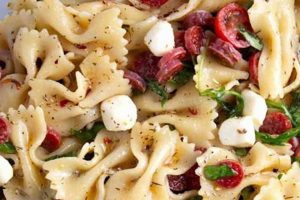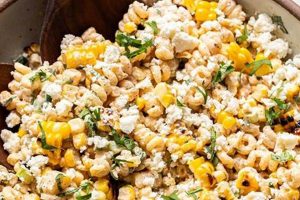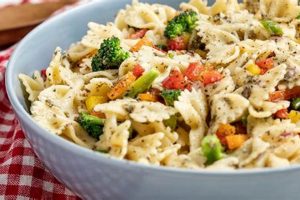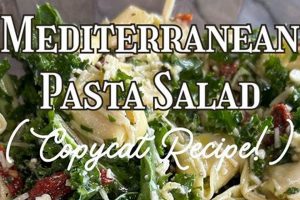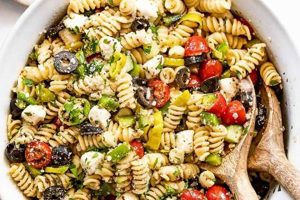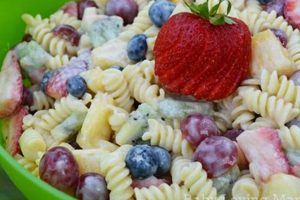A chilled dish featuring cooked pasta, typically short shapes like rotini, farfalle, or penne, combined with an assortment of fresh vegetables, cheeses, cured meats, and a vibrant, often vinaigrette-based, dressing characterizes this culinary creation. A classic example might include tri-color rotini, cherry tomatoes, black olives, mozzarella pearls, salami, and a dressing of olive oil, red wine vinegar, oregano, and garlic.
This type of dish offers a refreshing and versatile option for picnics, potlucks, and light meals. Its adaptability allows for endless variations based on seasonal ingredients and personal preferences, contributing to its widespread popularity. Furthermore, the historical roots of combining pasta with various ingredients, though not always in chilled form, can be traced back to Italy’s rich culinary heritage, providing a foundation for the contemporary versions enjoyed today.
The following sections will delve into specific ingredient selections, dressing variations, preparation techniques, and creative serving suggestions for crafting delightful and memorable versions of this dish.
Tips for Crafting a Delicious Pasta Salad
Achieving a well-balanced and flavorful pasta salad requires attention to several key elements. The following tips offer guidance for creating a dish that is both visually appealing and satisfying.
Tip 1: Cook Pasta Properly. Pasta should be cooked al dente, meaning firm to the bite. Overcooked pasta will result in a mushy salad. Rinse the cooked pasta under cold water to stop the cooking process and cool it down quickly. This also helps remove excess starch, preventing the salad from becoming sticky.
Tip 2: Select High-Quality Ingredients. Fresh, seasonal vegetables enhance both the flavor and visual appeal. Choose ripe tomatoes, crisp cucumbers, and vibrant bell peppers. Using high-quality olive oil and aged cheeses elevates the overall taste profile.
Tip 3: Balance Flavors. Consider the balance of salty, sweet, acidic, and savory elements. The dressing should complement the other ingredients without overpowering them. A touch of sweetness from sun-dried tomatoes or a hint of saltiness from olives can create a delightful complexity.
Tip 4: Dress the Salad Shortly Before Serving. Adding the dressing too early can cause the pasta and vegetables to become soggy. Toss the salad with the dressing just before serving to maintain optimal texture and flavor.
Tip 5: Use a Variety of Textures and Colors. Incorporating different textures, such as crunchy vegetables and creamy cheese, adds interest. A colorful array of ingredients makes the salad more visually appealing. Consider adding elements like blanched green beans, roasted red peppers, or artichoke hearts.
Tip 6: Chill Thoroughly Before Serving. Chilling the salad allows the flavors to meld and enhances the refreshing qualities of the dish. Ideally, chill for at least 30 minutes before serving.
Tip 7: Don’t Overcrowd the Salad. Too many ingredients can make the salad difficult to toss and serve. Choose a selection of complementary ingredients that work well together without creating a chaotic mix.
By following these tips, one can create a pasta salad that is both delicious and visually appealing. Attention to detail and careful selection of ingredients are key to achieving a successful outcome.
The following section provides variations on classic recipes, offering inspiration for customized creations.
1. Pasta Shape (Short, Textured)
Pasta shape selection significantly influences an Italian pasta salad’s overall success. Short, textured pasta contributes to both the aesthetic presentation and the dish’s ability to hold the dressing effectively, resulting in a more flavorful and enjoyable culinary experience.
- Surface Area and Dressing Adherence
Short pasta shapes, particularly those with ridges, folds, or tubes, offer a greater surface area for the dressing to cling to. This ensures that each bite is infused with flavor, preventing a bland or watery salad. Rotini, farfalle, and penne exemplify shapes that maximize dressing adherence.
- Ease of Handling and Serving
Short pasta is easier to toss and serve compared to long strands like spaghetti or linguine. This practical aspect makes short pasta ideal for salads, particularly in buffet or picnic settings where convenient handling is crucial. The smaller size also facilitates even distribution of ingredients throughout the salad.
- Visual Appeal and Texture
The varied shapes and textures of short pasta contribute to a visually appealing salad. The interplay of different shapes adds visual interest and a pleasant textural experience. Consider the contrast between the spirals of fusilli and the shells of conchiglie, further enhancing the salad’s presentation.
- Traditional Italian Influence
The use of short pasta shapes in salads aligns with traditional Italian culinary practices. While longer pasta is often preferred for main courses, shorter varieties are frequently utilized in salads and other side dishes, reflecting authentic Italian cuisine.
The choice of short, textured pasta ultimately enhances the flavor, presentation, and overall enjoyment of an Italian pasta salad. This seemingly minor detail contributes significantly to the dish’s authenticity and success, demonstrating the importance of thoughtful ingredient selection in creating a harmonious and satisfying culinary experience.
2. Fresh, High-Quality Ingredients
The hallmark of an exceptional Italian pasta salad lies in the utilization of fresh, high-quality ingredients. This principle directly impacts the final dish’s flavor, texture, and overall culinary experience. Substandard ingredients compromise the potential of even the most meticulously crafted recipe, while superior ingredients elevate the salad from simple to sublime. Cause and effect are demonstrably linked; fresh produce results in vibrant flavors and crisp textures, while aged cheeses contribute nuanced, complex notes.
Consider the impact of using freshly picked, ripe tomatoes bursting with sweetness and juicy flesh compared to bland, out-of-season alternatives. Similarly, high-quality olive oil, with its peppery notes and smooth texture, adds depth and richness that cannot be replicated with inferior oils. Fresh basil, with its vibrant aroma and delicate flavor, provides an authentic Italian touch, while aged Parmesan cheese lends a salty, umami complexity that enhances the overall flavor profile. These examples illustrate the practical significance of ingredient selection in achieving an authentic and flavorful Italian pasta salad.
Investing in high-quality ingredients is not merely a culinary extravagance but a crucial step towards creating a truly exceptional dish. The freshness and quality of the components directly translate to a superior sensory experience, showcasing the inherent flavors of the individual ingredients while contributing to a harmonious and balanced final product. Challenges may arise in sourcing specific ingredients depending on seasonality and availability; however, prioritizing freshness and quality remains paramount in achieving a truly authentic and delicious Italian pasta salad. This understanding underscores the integral role of ingredient selection within the broader context of Italian culinary tradition.
3. Vinaigrette-based dressing
Vinaigrette-based dressings play a pivotal role in Italian pasta salad recipes, contributing significantly to the overall flavor profile and textural experience. The choice of vinaigrette directly influences the balance of acidity, sweetness, and herbaceous notes, complementing the other ingredients and enhancing their individual characteristics. Understanding the components and nuances of vinaigrette preparation is essential for creating a harmonious and authentic Italian pasta salad.
- Emulsification and Texture
A vinaigrette’s emulsification process, combining oil and vinegar, creates a cohesive dressing that coats the pasta and other ingredients evenly. This emulsification is crucial for distributing flavor and preventing the salad from becoming oily or watery. The balance of oil and vinegar affects the final texture, ranging from a light and tangy dressing to a richer, more viscous one.
- Acidity and Flavor Balance
The acidity of the vinaigrette, primarily derived from vinegar, provides a bright, refreshing counterpoint to the richness of the pasta and other ingredients. Common choices include red wine vinegar, white wine vinegar, and balsamic vinegar, each offering a distinct flavor profile. Balancing the acidity with a touch of sweetness, often from a small amount of honey or sugar, creates a more complex and nuanced dressing.
- Herbaceous and Aromatic Components
Fresh herbs, such as basil, oregano, and parsley, are essential components of Italian vinaigrettes, imparting aromatic complexity and enhancing the overall flavor profile. Garlic, shallots, and other alliums can also be incorporated, adding pungent notes that complement the other ingredients. The selection and combination of herbs and aromatics are crucial for creating a balanced and authentic Italian flavor.
- Complementary Flavor Pairing
The vinaigrette’s flavor profile should complement the other ingredients in the pasta salad, creating a harmonious balance. For example, a lemon-herb vinaigrette pairs well with seafood-based pasta salads, while a balsamic vinaigrette complements salads featuring roasted vegetables or cured meats. Consider the interplay of flavors between the dressing and the other ingredients to achieve a cohesive and well-rounded culinary experience.
A well-crafted vinaigrette elevates the Italian pasta salad beyond a simple combination of ingredients, transforming it into a cohesive and flavorful dish. The careful balance of acidity, sweetness, and herbaceous notes, combined with a stable emulsion, ensures that the dressing enhances the other components, creating a harmonious and authentic Italian culinary experience. The choice of vinaigrette should reflect the specific ingredients in the salad, further emphasizing the importance of this element in achieving a balanced and delicious final product.
4. Italian-inspired flavors
Authentic Italian flavors form the foundation of a successful Italian pasta salad recipe. These flavors, derived from specific ingredients and their combinations, distinguish the dish from other pasta salads and contribute significantly to its unique character. Understanding the core components of these flavors provides a framework for creating an authentic and satisfying culinary experience.
- Fresh Herbs and Aromatics
Fresh herbs, such as basil, oregano, and parsley, are indispensable in Italian cuisine. Their aromatic qualities infuse the pasta salad with distinctive flavors, creating a refreshing and herbaceous profile. Basil, with its sweet, slightly peppery notes, is a classic pairing with tomatoes and mozzarella. Oregano, possessing a more pungent, earthy flavor, complements olives and artichoke hearts. Parsley, with its clean, fresh taste, provides a balancing element. The strategic use of these herbs elevates the pasta salad, contributing to its authentic Italian character.
- High-Quality Olive Oil
Extra virgin olive oil, a cornerstone of Mediterranean cuisine, plays a crucial role in Italian pasta salads. Its fruity, peppery notes enhance the flavors of the other ingredients, while its smooth texture contributes to the overall sensory experience. The quality of the olive oil directly impacts the final dish; opting for a high-quality extra virgin olive oil ensures a richer, more complex flavor profile.
- Cured Meats and Cheeses
The inclusion of cured meats, such as salami, prosciutto, or mortadella, adds a savory, salty dimension to the pasta salad. These meats, often combined with cheeses like mozzarella, provolone, or Parmesan, create a complex interplay of flavors and textures. The saltiness of the meats complements the creamy richness of the cheeses, while the varying textures add depth and interest to each bite.
- Vinegar and Acidity
The judicious use of vinegar, typically red wine vinegar or balsamic vinegar, introduces a necessary acidic element that balances the richness of the other ingredients. The acidity brightens the flavors, preventing the salad from becoming overly heavy or cloying. The type of vinegar selected contributes its own unique flavor profile; red wine vinegar offers a sharper, more assertive tang, while balsamic vinegar imparts a subtle sweetness and complexity.
These key elements, when combined thoughtfully, create a symphony of Italian-inspired flavors that define an authentic Italian pasta salad. The interplay of fresh herbs, high-quality olive oil, cured meats and cheeses, and the balancing acidity of vinegar results in a dish that is both refreshing and deeply flavorful. Understanding the nuances of these flavors allows for creative variations while maintaining the integrity of the Italian culinary tradition. The result is a pasta salad that transcends a simple side dish, becoming a celebration of Italian culinary heritage.
5. Balance of Textures and Colors
Texture and color significantly influence the sensory experience of consuming an Italian pasta salad. A well-executed balance of these elements elevates the dish beyond mere sustenance, transforming it into a multi-sensory culinary experience. This balance contributes to visual appeal, textural diversity, and flavor perception, all crucial components of a successful and satisfying dish. Cause and effect are directly linked; the intentional inclusion of varied textures and colors results in a more engaging and enjoyable meal.
Consider the interplay of textures: al dente pasta provides a firm foundation, while crisp vegetables, such as bell peppers or cucumbers, offer a refreshing crunch. Soft cheeses, like mozzarella or bocconcini, contribute a creamy element, contrasted by the potential addition of crunchy croutons or toasted nuts. This diversity of textures stimulates the palate, creating a dynamic eating experience. Visually, the vibrant colors of fresh vegetables the deep red of tomatoes, the verdant green of spinach, the bright yellow of bell peppers create an aesthetically pleasing presentation. This visual appeal enhances the overall perception of freshness and quality, influencing enjoyment before the first bite is even taken. The practical significance of this understanding lies in the ability to construct a pasta salad that is not only delicious but also visually stimulating and texturally diverse.
Achieving this balance requires careful ingredient selection and preparation. Blanching vegetables, for example, can enhance their color while maintaining a desirable crispness. Roasting vegetables can intensify their sweetness and create a slightly charred texture. Thoughtful consideration of these techniques allows for precise control over the final product. Challenges may arise when combining ingredients with vastly different textures or colors, requiring adjustments to dressing consistency or ingredient proportions to maintain balance and prevent a visually or texturally overwhelming dish. The successful navigation of these challenges, however, underscores the importance of texture and color balance in crafting an exceptional and authentic Italian pasta salad.
6. Proper Chilling
Proper chilling is a crucial step in preparing an Italian pasta salad, significantly impacting food safety, flavor development, and overall enjoyment. Chilling allows the flavors of the various ingredients, including the pasta, vegetables, cheeses, and dressing, to meld and harmonize. It also ensures the salad maintains a desirable temperature for consumption, particularly during warmer weather. Neglecting proper chilling can lead to bacterial growth, flavor degradation, and a less refreshing dining experience.
- Food Safety
Chilling inhibits the growth of harmful bacteria that can cause foodborne illnesses. Leaving pasta salad at room temperature for extended periods, especially those containing mayonnaise-based dressings or perishable ingredients like meat and cheese, creates an environment conducive to bacterial proliferation. Prompt and adequate chilling is essential for maintaining food safety and preventing potential health risks.
- Flavor Development
Chilling allows the flavors of the individual ingredients to meld and deepen. The absorption of the dressing by the pasta and vegetables enhances their flavor profiles. This process of flavor integration is particularly noticeable in pasta salads with complex vinaigrettes or a variety of ingredients, resulting in a more harmonious and well-rounded taste experience. The cooler temperature also enhances the perception of certain flavors, particularly the refreshing notes of herbs and acidic components.
- Texture Enhancement
Chilling helps maintain the desired texture of the pasta and vegetables. It prevents the pasta from becoming mushy and the vegetables from wilting, preserving their crispness and structural integrity. This is especially important in pasta salads containing a variety of ingredients with differing textures, ensuring a pleasant and balanced mouthfeel.
- Enhanced Refreshment
A chilled pasta salad offers a refreshing and revitalizing culinary experience, especially during warmer months. The cool temperature enhances the perception of freshness and provides a welcome contrast to the ambient heat. This characteristic makes Italian pasta salad an ideal choice for picnics, barbecues, and other outdoor gatherings.
Proper chilling, therefore, is not merely a final step but an integral component of the Italian pasta salad preparation process. Its impact on food safety, flavor development, textural integrity, and overall enjoyment underscores its significance in achieving a successful and satisfying culinary outcome. By adhering to proper chilling guidelines, one ensures not only the deliciousness of the dish but also the well-being of those who consume it.
Frequently Asked Questions
This section addresses common inquiries regarding the preparation and enjoyment of Italian pasta salad, offering practical guidance and clarifying potential misconceptions.
Question 1: What is the best type of pasta to use in an Italian pasta salad?
Short, textured pasta shapes like rotini, farfalle, or penne are ideal. These shapes hold the dressing well and contribute to a pleasant textural experience.
Question 2: Can Italian pasta salad be made ahead of time?
Yes, it can be prepared a day in advance. However, it’s recommended to add the dressing shortly before serving to prevent the salad from becoming soggy.
Question 3: How long can Italian pasta salad be stored in the refrigerator?
Properly stored in an airtight container, it can be refrigerated for up to three days.
Question 4: What are some common variations on the classic Italian pasta salad recipe?
Variations may include the addition of different vegetables, cheeses, cured meats, or beans. Experimentation with dressings, such as pesto or a lemon-herb vinaigrette, can also create unique flavor profiles.
Question 5: How can one prevent the pasta salad from becoming too dry?
Ensure the pasta is cooked al dente and cooled properly. Adding a sufficient amount of dressing and tossing the salad gently will help maintain moisture.
Question 6: Is it necessary to use fresh herbs in an Italian pasta salad?
While dried herbs can be substituted in a pinch, fresh herbs like basil, oregano, and parsley significantly enhance the flavor and aroma of the salad, contributing to a more authentic Italian experience.
Understanding these frequently asked questions facilitates successful preparation and enjoyment of Italian pasta salad. Careful consideration of these points ensures a delicious and satisfying culinary outcome.
Further exploration of Italian culinary traditions and related pasta dishes will be presented in the following sections.
Conclusion
Exploration of this culinary creation reveals the importance of specific components: pasta shape selection emphasizing short, textured varieties; ingredient quality highlighting fresh, seasonal produce; vinaigrette composition balancing acidity, sweetness, and herbaceous notes; authentic Italian flavors derived from fresh herbs, olive oil, and cured meats; balanced textures and colors enhancing sensory appeal; and proper chilling ensuring food safety and flavor integration. Each element contributes significantly to the overall quality and authenticity of the dish.
Mastery of these components allows for creative exploration and personalized adaptations while maintaining the integrity of this classic dish. Continued appreciation and exploration of this culinary tradition promise a vibrant and evolving culinary landscape, enriching dining experiences for generations to come. Careful consideration of these elements ensures a satisfying and authentic culinary outcome, reflecting a deep appreciation for the art of Italian cuisine.

